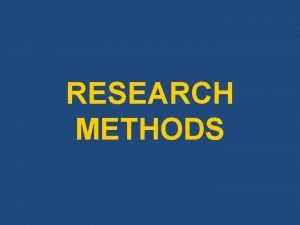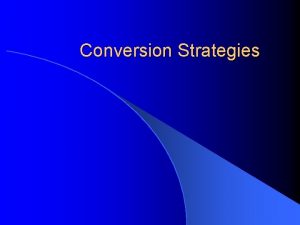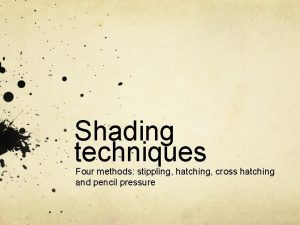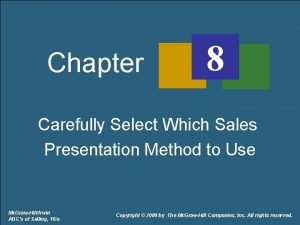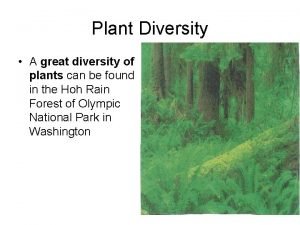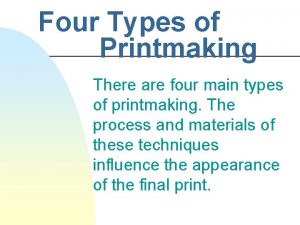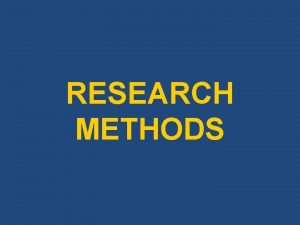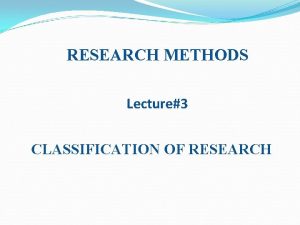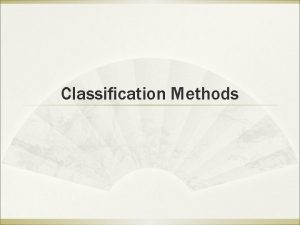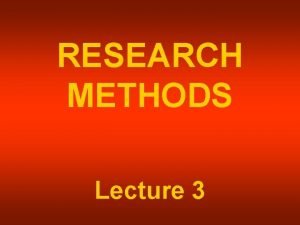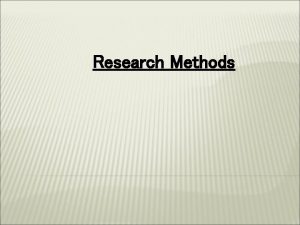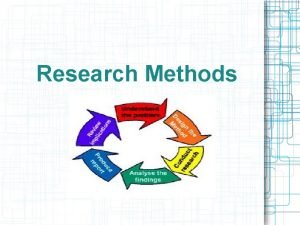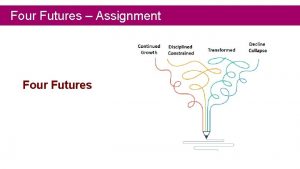RESEARCH METHODS CLASSIFICATION OF RESEARCH Four main dimensions
















- Slides: 16

RESEARCH METHODS

CLASSIFICATION OF RESEARCH

Four main dimensions: 1. Purpose of doing research. 2. Intended uses of research. 3. How it treats time dimension. 4. The research techniques used

1. Purpose of Research What the researcher trying to accomplis a. Exploratory ﺇﺳﺘﻄﻼﻋﻲ /Formulative b. Descriptive c. Explanatory ﺗﻮﺿﻴﺤﻲ Studies can be multipurpose

a. Exploratory Research ﺇﺳﺘﻄﻼﻋﻲ • Initial research conducted to clarify and define the nature of the problem. • Exploring a new topic. • Specifically there could be number of goals of exploratory research.

Goals of Exploratory Research • Become familiar with the topic. Develop well grounded picture of the situation. • Develop tentative ﻣﺆﺕ theories. • Determine the feasibility of study. • Formulate questions and refine issues for more systematic inquiry. • Develop techniques and a sense of direction for future research

b. Descriptive Research • Research designed to describe characteristics of the phenomenon understudy. • Helps in diagnostic analysis • Specific goals can be:

Goals of Descriptive Research • Describe the situation/characteristics. • Provide an accurate profile of a group. • Give a verbal ﺷﻔﻮﻱ or numerical picture (%). • Present basic background information. • Create a set of categories or classify. • Clarify sequence, set of stages. • *Focus on ‘who’, ‘what’, ‘when’, ‘where’ and ‘how’ but not on ‘why’.

c. Explanatory ﺗﻮﺿﻴﺤﻲ Research • Also called as causal research i. e. • ‘Why’? Explanation. • Identify cause and effect relationship among different factors.

Goals of Explanatory Research • • Explain things not just reporting. Why? Which explanation is better. Determine the accuracy of theory. Advance knowledge about underlying process Build and elaborate ﻣﺘﻘﻦ a theory complete. Extend a theory or principle into new areas. Provide evidence to support or refute ﺩﺣﺾ an explanation or prediction.

2. The Uses of Research a. Basic Research • Pure/fundamental/academic • Developing/refuting ﺩﺣﺾ /supporting theories. Expand knowledge. • Explanatory research is the most common • Applied can also contribute.

b. Applied Research • Solve specific problems help practitioners ﺍﻟﻤﻤﺎﺭﺳﻮﻥ. Market new product. • Choose one policy over the other. • For improving productivity problem with machines, raw material, persons working.

Basic and applied research compared Basic Applied • Intrinsically ﺟﻮﻫﺮﻳﺎ satisfying • Research part of job • Freedom. • Constrained ﻣﺤﺩ to demands of sponsors • Hi standards applied. • Research quick may not meet hi standards. • Logic and rigorous ﺻﺎﺭﻡ research design • Apply to areas of interest to sponsors. • Basic knowledge. • Practical applications. • Success results published, impact on other scientists. • Success results are used by sponsors.

Types of Applied Research - Action research: Those who are being studied participate in research process; research incorporates popular knowledge; focus on power with goal of empowerment increase ﻫﺪﻑ ﺯﻳﺎﺩﺓ ﺍﻟﻮﻋﻲ awareness; tied to political action - Impact Assessment: Estimate the likely consequences of planned change. - Evaluation Research: Did the program work? Measures the effectiveness of program.

3. Time Dimension of Research • Cross-Sectional Research: Observe at one point in time. Snapshot study. • Longitudinal Research: Examine at more than one time. Can be - Time series study. - Panel study. - Cohort ﻣﺠﻤﻮﻋﺔ study – Category of people who share the same experience.

4. Research Techniques Used Quantitative & Qualitative • Experimental technique. • Surveys. • Content analysis. • Use of existing statistics. • Field research. • Case study. • Focus group discussions » Mixed methods/techniques
 Example of dimension in research
Example of dimension in research Indirect methods of contoring uses how many methods
Indirect methods of contoring uses how many methods What is the website access accenture delivery suite
What is the website access accenture delivery suite Acceptable methods for thawing food
Acceptable methods for thawing food Formal amendment process definition
Formal amendment process definition Direct cutover conversion strategy
Direct cutover conversion strategy Smudging drawing
Smudging drawing What are the four common methods of voting in ffa
What are the four common methods of voting in ffa Four sales presentation methods
Four sales presentation methods Expressing the future
Expressing the future What is about
What is about Void main int main
Void main int main The most ancient surviving seed plants are the
The most ancient surviving seed plants are the Four main groups of plants
Four main groups of plants What are the four main attributes of professional image
What are the four main attributes of professional image Four major process of printmaking
Four major process of printmaking Four main components for effective outlines
Four main components for effective outlines
